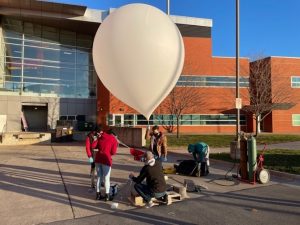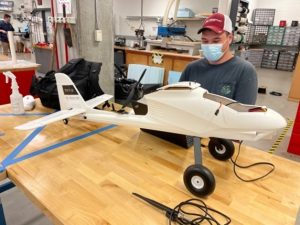M:2:I program navigates pandemic, charts future growth in hands-on learning
Author: John Burnett-Larkins
Author: John Burnett-Larkins
As with many university programs, Make to Innovate (M:2:I) in the Department of Aerospace Engineering, has persevered through a challenging time since the onset of the COVID-19 pandemic. It forced a restructuring of how students are educated through the program’s hands-on learning. Despite the challenges, the students have been very active and engaged and that spirit has shown through the work they have accomplished. Highlights include:

The High Altitude Balloon Experiment in Technology (HABET), one of the oldest and longest-running groups in M:2:I. HABET was able to conduct several flight missions and has been testing new hardware, which includes a new tracking system that greatly reduces the craft’s weight and power consumption. In addition, the students have been experimenting with 3D printed enclosures and enclosures that make it easier to support a wider range of experiments.
A big moment in the history of the HABET program is scheduled for August 14, 2021 at the Iowa State Fair, when the program will initiate “Launching Foods in Space.” This unique effort will send foods skyward aboard the HABET balloon. It is being coordinated with Iowa State Extension and Outreach 4-H Youth Development, the Iowa Space Grant Consortium and the Stratospheric Ballooning Association.
CySat, the M:2:I CubeSat project, has seen students developing CySat-1, which is getting closer to launch. The onset of the pandemic delayed the original launch planned in the summer of 2020.
The team has finalized the satellite structure and ordered a new solar panels board; and has worked with Iowa State’s Department of Electric and Computer Engineering and a senior design team that has been finalizing the software and hardware for the satellite’s on-board computer, radio, and payload sub-systems. The project is on track to have the satellite finished in the summer of 2021 with an expected launch aboard SpaceX mission CRS-24, which is currently planned for launch in December, 2021.
The Rocket-Assisted Free Fall (RAFF) team is constructing a rocket capable of carrying a variety of payloads that can be part of other instructional courses, research, or working with outreach in the community. This project will allow the payloads to experience more extended moments of weightlessness at a much more feasible cost than other options currently available at Iowa State University.

The JARVIF (Just a Rather Very Intelligent Flyer) team has made great strides for both M:2:I as a service team and department research in development of Unmanned Aerial Vehicles (UAVs).
Recently the team overcame hardware hurdles and obtained a successful test flight of both hardware and software systems. The team will use this knowledge on seven different model planes to test different control systems both externally and internally. This progress is a significant step forward and will allow M:2:I to have better flight procedures and test platform understanding for all UAV projects.
Sponsored by Boeing, M:2:I has also received support from both personal contributions and from industry. M:2:I’s truly innovative experience, which is not limited to Department of Aerospace Engineering students, will continue to grow through continued development of cooperative work with other Iowa State University College of Engineering departments.
See more information about M:2:I and information on how to support the program through the ISU Foundation.